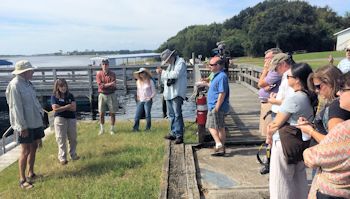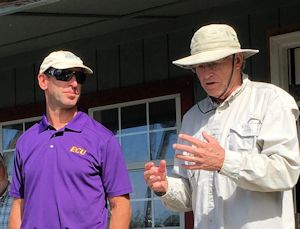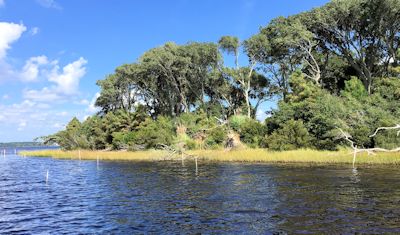Reprinted from the Tideland News

SWANSBORO — Despite what you might hear, there’s strong evidence that climate change is having an impact on North Carolina: Look carefully at the fish.
Supporter Spotlight
That was one of the messages from Pete Peterson, a researcher and professor at the University of North Carolina’s Institute of Marine Sciences in Morehead City. He was among the scientists, TV weathermen and journalists on the boat Friday touring the marshes of the White Oak River. The boat trip was part of a workshop on climate change’s effects on coastal habitats organized by the N.C. Coastal Federation.
Greg “Rudi” Rudolph, the Carteret County Shore Protection Office manager, and Todd Miller, the federation’s executive director, also spoke on the tour, which included stops at Bear and Jones islands in Hammocks Beach State Park.
Others on the trip – and who spoke and participated Friday evening and Saturday morning during sessions at the Duke University Marine Laboratory in Beaufort – included Susan Hassol, director of Climate Communication; Michael Mann, who as director of the Earth Systems Science Center in the Department of Meteorology at Penn State University is a heavyweight in the study of climate change; Tom Peterson, president of the World Meteorological Organization’s Commission for Climatology and former principal scientist for NOAA’s National Climatic Data Center in Asheville; Ryan Broyles, North Carolina’s state meteorologist; and Greg Fishel, chief meteorologist at WRAL-TV in Raleigh. Participating media came from all around North Carolina.
The focus of the trip on the Lady Swan, a Swansboro-based ferry, was to see some of the more effective means being used to combat the effects of rising sea level and other impacts of climate change.

Peterson, whose work involves research and teaching grad students in paleoecology, invertebrate fisheries management, estuarine habitat evaluation and barrier island ecology, said that it’s fairly easy to see the effects on local waters and fish.
Supporter Spotlight
For example, he said, a thermometer hung for decades in the water off the bridge to Pivers Island – home of NOAA’s Beaufort Lab and the Duke Lab – clearly shows a 1.8-degree Fahrenheit rise in water temperatures in the past two decades.
At the same time, Peterson said, there’s been an equally clear shift in the composition of fish stocks in some locations. The NOAA lab, he said, has for decades sampled reef fish, and has found that over the past four decades, there’s been a marked decrease in the number of northern, temperate species, and a corresponding dramatic increase in the number of tropical species.
Peterson, Miller and Lexia Weaver, a federation scientist, also led extensive discussions of the use of natural, or “living,” shorelines as an alternative to combat erosion that has always occurred and is almost sure to accelerate as sea level rises in response to warming water temperatures.
They pointed out the success of some of those projects at Hammocks Beach State Park, both on the mainland, at the ferry dock, and at Jones Island. In both cases, the projects, which use oyster shells and marsh grass, have stabilized shorelines.
A major benefit in a time of rising sea levels, Miller said, is that the living shorelines allow the marsh to migrate inland as the sea level rises. Bulkheads, the more common method of erosion control, don’t. As the sea rises, the marsh in front of the wall is overcome along with everything else. The wall itself will eventually need major repairs or complete replacement.

Peterson said one of his former graduate students, Rachel Gittman, did an extensive study of living shorelines and bulkheads after Hurricane Irene, a large and destructive Category One storm that severely affected Carteret and other coastal counties in 2011. While seawalls and bulkheads might look “massive and permanent,” Peterson said, the study showed that they fared far worse – with some over-wash, some breaches and some complete failures – than the living shorelines, which generally were unscathed.
And that doesn’t even take into consideration the significant “ecosystem services” provided by living shorelines, Peterson added. The oyster shells attract baby oysters, or spat, and eventually become living reefs that filter water and attract a variety of marine life.
As climate change helps to produce stronger storms and more wave energy, along with sea-level rise, it will be increasingly important to use erosion control methods that not only are effective, but also preserve as much of the natural habitat as possible, Peterson and the others said, because that habitat is the engine for reproduction of fish and shellfish that are so valuable to the state’s coastal economy and way of life.
Living shorelines, Miller said, are gaining in acceptance, because of their effectiveness and low long-term cost, but “a lot of education is still necessary” in order for them to gain more widespread use and provide the “resiliency” needed as climate change impacts increase in severity.
He also said he believes that beach re-nourishment – if done properly, using the proper materials, with those who benefit bearing most of the cost – helps buy time and provides good short-term protection of the ocean beaches that are so crucial to the coastal tourism economy.

Miller, however, cautioned that as the effects of climate change become more pronounced, even living shorelines probably won’t be enough.
“My opinion is that for now, we need to do the things that do the least harm,” he said. “Sooner or later, living shorelines are not going to be able to stop (erosion and habitat loss), but probably nothing else will, either.”
The goal, Miller said, should be to try to ensure that as much of the crucial habitat as possible survives.
Rudolph spent much of his time talking about the practicality of making policy decisions for dealing with climate change. Market incentives – providing cost breaks for insurance for property owners who elevate structures above expected flood levels, for example – are probably doing more than anything else to help address current and future impacts of climate change, he said.







